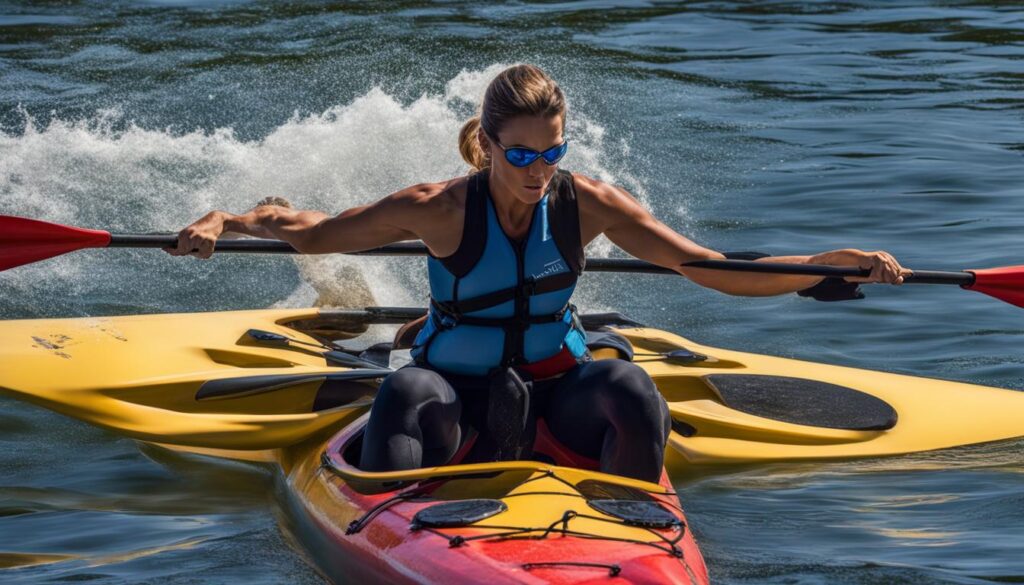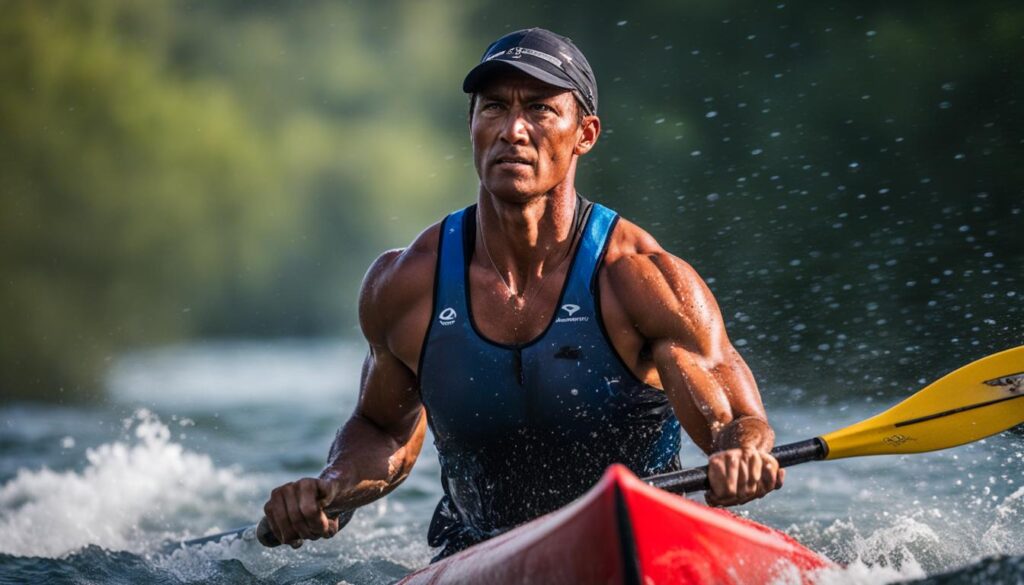Strength training for kayaking is a targeted workout regimen designed to improve your paddling performance by building essential muscle groups and enhancing overall power. By focusing on specific areas such as the core muscles, latissimus dorsi, forearms and wrists, legs, hip flexors, triceps, and biceps, you can take your kayaking strength and conditioning to the next level.
Building muscular endurance for paddling is key, and incorporating strength training exercises into your routine can offer a range of benefits. Not only will it increase your paddling efficiency, but it will also enhance your stability and balance on the water. Additionally, strength training helps to prevent injuries and boost your confidence and mental resilience.
Key Takeaways:
- Strength training focuses on specific muscle groups to improve paddling performance.
- Incorporating strength training enhances paddling efficiency, stability, and balance.
- Building muscular endurance through targeted workouts helps prevent injuries and boosts confidence.
- The core, upper body, legs, and hip flexors are essential areas of strength for paddlers.
- By following a comprehensive strength training plan tailored to your needs, you can unlock your full potential on the water.
Importance of Core Muscles in Paddling
When it comes to kayaking, strong core muscles are crucial for maintaining balance, stability, and overall paddling performance. The core, consisting of the abdominal and lower back muscles, plays a vital role in torso rotation and power transfer from the upper to lower body. By strengthening these muscles, you can significantly improve your ability to paddle efficiently and with better control.
A strong core enables you to generate more power with each paddle stroke, resulting in increased speed and endurance. It also helps you maintain proper posture while kayaking, reducing the risk of strain or injury. By engaging your core muscles, you can achieve better balance and stability on the water, allowing you to navigate through challenging conditions with confidence.
To target your core muscles effectively, incorporate exercises such as planks, Russian twists, and bicycle crunches into your strength training routine. These exercises engage multiple core muscles and promote stability, helping you develop a strong and resilient core that will enhance your paddling performance.

| Benefits of Strong Core Muscles for Paddlers |
|---|
| Improved balance and stability on the water |
| Enhanced torso rotation for more powerful paddle strokes |
| Increased paddling efficiency and endurance |
| Reduced risk of strain and injury |
| Boosted confidence and control while kayaking |
Strengthening the Upper Body for Paddlers
In the world of kayaking, having a strong upper body is essential for optimal performance on the water. Building strength in specific muscle groups such as the latissimus dorsi, forearms and wrists, triceps, and biceps can greatly enhance your paddling ability and overall power. Let’s explore why these muscles are crucial and how to effectively train them.
Latissimus Dorsi: The Powerhouse
The latissimus dorsi, commonly referred to as the “lats,” are the largest muscles in the upper body. They play a significant role in paddling by providing power and propulsion during each stroke. Strengthening these muscles not only improves your ability to paddle for extended periods but also enhances the efficiency of your strokes. Exercises such as pull-ups, lat pulldowns, and seated rows are excellent for targeting and strengthening the latissimus dorsi.
Forearms and Wrists: Grip and Precision
Having a firm grip on the paddle is crucial for control and power in your strokes. Strengthening your forearms and wrists allows for better paddle control and more precise movements. It also helps prevent fatigue and reduce the risk of injuries such as wrist strain. Incorporate exercises like wrist curls, reverse curls, and grip strengtheners into your routine to develop strong forearms and wrists.
Triceps and Biceps: Control and Stability
The triceps and biceps are responsible for the control and stability of your paddle stroke. Strong triceps ensure a controlled extension of the arm during the stroke, while well-developed biceps assist in the power phase. Push-ups, tricep dips, and bicep curls are effective exercises for targeting and strengthening these muscles.
By incorporating targeted upper body exercises into your strength training routine, you can improve your paddling performance, increase endurance, and reduce the risk of injury. Remember to warm up properly before each session and gradually increase the intensity and resistance of your workouts. With consistent training, you’ll notice significant improvements in your upper body strength and overall paddling ability.

Table: Upper Body Strengthening Exercises
| Exercise | Targeted Muscles |
|---|---|
| Pull-ups | Latissimus dorsi, biceps, forearms |
| Lat Pulldowns | Latissimus dorsi, biceps, forearms |
| Seated Rows | Latissimus dorsi, biceps, forearms |
| Wrist Curls | Forearms, wrists |
| Reverse Curls | Forearms, biceps |
| Grip Strengtheners | Forearms, wrists |
| Push-ups | Triceps, chest, shoulders |
| Tricep Dips | Triceps, shoulders |
| Bicep Curls | Biceps |
Importance of Leg Strength for Paddling
When it comes to paddling, many people focus on the upper body strength, but neglecting the legs can be a missed opportunity for enhanced performance. Building leg strength is crucial for paddlers, as it not only provides stability but also plays a key role in power transfer during each stroke. Incorporating specific leg exercises into your training routine can greatly improve your paddling experience.
Why leg strength matters
Having strong legs is essential for maintaining stability while kayaking. The legs act as a solid base, helping to prevent tipping or swaying, especially when encountering choppy water or strong currents. Without sufficient leg strength, you may find it challenging to maintain balance and control, which can affect your overall paddling efficiency.
In addition to stability, leg strength is vital for power transfer during paddle strokes. Each stroke requires a strong push from the legs to drive the paddle forward. A powerful leg drive ensures a more efficient transfer of energy from your lower body to your upper body, resulting in stronger and more effective strokes. By strengthening your leg muscles, you can generate greater force and paddle with increased power, allowing you to cover more distance and maintain a faster pace.
Preventing injuries
Strengthening your legs also helps reduce the risk of injuries while paddling. The repetitive motion of paddling can put strain on various muscle groups, including the legs. By strengthening the muscles in your legs, you can provide better support and stability, reducing the impact on your joints and minimizing the risk of overuse injuries. Strong leg muscles can also help absorb the shock caused by waves or sudden movements, protecting your body from unnecessary stress and potential injuries.
| Leg Exercises for Paddlers | Benefits |
|---|---|
| Lunges | Strengthens quadriceps, hamstrings, and glutes for improved power and stability |
| Squats | Targets leg muscles, including quadriceps, hamstrings, and calves, to enhance overall strength and endurance |
| Step-ups | Builds strength in the quadriceps, hamstrings, and glutes to improve stability and power transfer |
| Calf raises | Targets the calf muscles for improved balance and control |
By incorporating these leg exercises into your strength training routine, you can develop stronger leg muscles that will support you during your kayaking adventures. Remember to always warm up before exercising and listen to your body to avoid overexertion or injury. With stronger legs, you’ll have the stability, power, and endurance needed to take your paddling to the next level.
Enhancing Stability and Balance Through Hip Flexor Strength
When it comes to kayaking, maintaining proper posture, balance, and stability is key to maximizing your performance on the water. One area that plays a crucial role in achieving these goals is the hip flexors. These group of muscles, located in the front of your hips, are responsible for leg lifting and bending at the hips. Strengthening your hip flexors through targeted exercises can greatly enhance your stability and balance, leading to improved power transfer during paddle strokes.
Strong hip flexors enable you to maintain an upright posture while kayaking, preventing excessive leaning or slouching that can negatively affect your paddling technique. By keeping your body aligned, you’ll be able to generate more power and efficiency in each stroke, propelling yourself through the water with greater ease.
Incorporating exercises that specifically target the hip flexors into your strength training routine can yield significant benefits. Leg lifts, hip raises, and mountain climbers are examples of exercises that engage these muscles and help to build their strength. By consistently working on your hip flexor strength, you’ll increase your overall stability, improve your balance, and optimize your power transfer from your lower body to your upper body for more effective paddling.
Remember to always consult with a professional trainer or coach before starting any new exercise program to ensure proper form and technique. With consistent training and a focus on strengthening your hip flexors, you’ll be well on your way to becoming a more stable and balanced paddler.
Conclusion
Strength training is crucial for paddlers looking to improve their performance on the water. By targeting specific muscle groups such as the core, upper body, legs, and hip flexors, paddlers can enhance their paddling efficiency, stability, endurance, and overall power.
Incorporating strength training exercises into a kayaker’s workout routine can also help prevent injuries and boost confidence and mental resilience. By following a comprehensive strength training plan tailored to individual needs, paddlers can unlock their full potential and enjoy a more rewarding paddling experience.
So, whether you’re a recreational paddler or a professional kayaker, don’t underestimate the importance of strength training. By dedicating time and effort to strengthen your body, you’ll reap the benefits both on and off the water. So grab your paddle, hit the gym, and get ready to take your kayaking to the next level!
FAQ
What is strength training for kayaking?
Strength training for kayaking is a targeted workout regimen designed to improve paddling performance by building essential muscle groups and enhancing overall power.
Which muscle groups does strength training for kayaking focus on?
Strength training for kayaking focuses on specific areas such as the core muscles, latissimus dorsi, forearms and wrists, legs, hip flexors, triceps, and biceps.
What are the benefits of incorporating strength training for kayaking?
Incorporating strength training for kayaking offers benefits such as increased paddling efficiency, enhanced stability and balance, increased endurance, injury prevention, and boosted confidence and mental resilience.
What are some exercises that can be included in a kayaker’s strength training routine?
Some exercises that can be included are pull-ups, lat pulldowns, seated rows, push-ups, lunges, and Russian twists.
How does strengthening the core muscles help in kayaking?
Strengthening the core muscles improves torso rotation and power transfer from the upper to lower body, leading to improved paddling performance.
Why are the upper body muscles important for kayaking?
The upper body muscles, such as the latissimus dorsi, forearms and wrists, triceps, and biceps, are essential for efficient paddling and contribute to a more controlled and powerful paddle stroke.
What role do the legs play in kayaking?
The legs provide a stable base and assist in power transfer during paddle strokes. Strengthening the leg muscles improves overall performance and reduces the risk of injury.
How do hip flexors contribute to paddling performance?
Hip flexors aid in maintaining proper posture and balance while kayaking. They also help transfer power from the lower to the upper body during paddle strokes, enhancing stability, balance, and overall performance.





